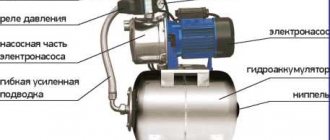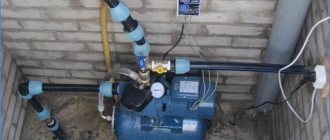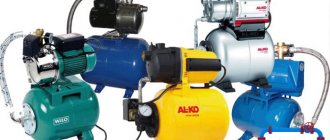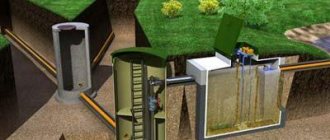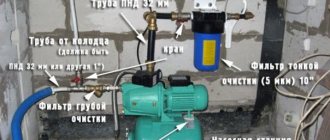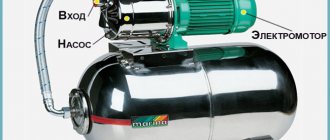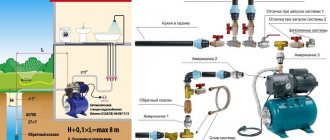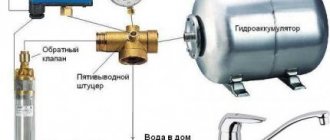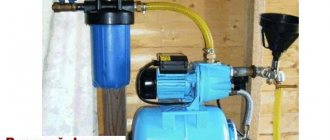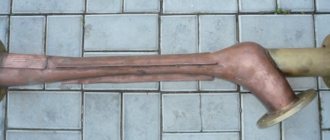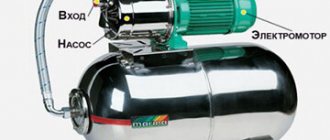Our company RusWater provides installation services for autonomous water supply systems for private houses, cottage villages, and populated areas. The cost of the service depends on the water source and connection method.
To find out the cost of installing water supply for your home, fill out the form below. The manager will call you back to discuss all the details of the project, after which an estimate will be drawn up. You will receive preliminary consultations and estimate preparation free of charge. After agreeing on the terms and signing the contract, within three to five days you will become the owner of an autonomous water supply network!
Options and purpose
A water supply pumping station for a home is installed in the supply system; water is supplied from outside under pressure into the pipeline. Another option for installing a plumbing system is gravity-flow; it does not require any additional equipment. In this case, water is pumped into a storage tank installed above the level of the highest water intake point. For example, in the attic, from where it flows by gravity into the network, thereby creating pressure.
However, the gravity-flow system has a significant disadvantage, which is the need to allocate a separate warm room for the storage tank so that the water in it does not freeze. Considering that water consumption in a comfortable house inhabited by a family of 4 people can reach 1-1.5 m2 per day, we can imagine the volume of the required storage tank.
Another option, water pressure, involves creating pressure in the network by a certain unit, which is often a pump immersed in a well. This option is often used in summer cottages where the number of water points is minimal. You just need to plug in the pump and a stream of water will flow from the hose. However, this option is not suitable for providing water to a comfortable home with people living in it year-round.
A full-fledged comfortable house with an autonomous water supply requires stable pressure in the water supply. Its indicator must comply with the technical requirements of household equipment and plumbing fixtures connected to the water supply network.
Otherwise, automatic washing machines or instantaneous hot water boilers simply will not turn on, and a thin stream of water will flow from the shower. The installation of a pumping station is designed to solve this problem.
Development of a water supply project
If in urban conditions providing a facility with water requires connection to a central water supply system, then owners of country houses, dachas and cottages often do not have this opportunity. The only way out in this case is the installation of an autonomous water supply system with accompanying drilling of a well. Designing water supply and carrying out a full range of drilling and installation work at a professional level will ensure uninterrupted delivery of the highest quality water to the consumer.
Our company offers the development of a water supply project and related hydraulic structures for objects of any type - from private houses, dachas, cottages and cottage communities - to large industrial facilities.
What do we offer:
- Drawing up a water supply diagram.
- Development of project documentation.
- Coordination of the project with supervisory authorities.
- Calculation of estimates for the entire range of work carried out and services provided.
It is possible to interface a water supply project with projects for organizing water treatment, heating, etc., as well as integration as a module of the Smart Home system.
Preparation of a project, for example, a country house, usually takes 7 working days. The first visit of a specialist from our company to get acquainted with the property and provide a preliminary consultation is free.
Installation of water supply from the company RusWater
Our company provides services for organizing water supply to various facilities and buildings:
- Country houses, cottages, dachas;
- Cottage and holiday villages;
- Water supply for two houses from one well;
- Water supply for agricultural farms and industrial production.
Many successfully completed projects and extensive experience allow us to guarantee the highest quality of work. Call us and see for yourself!
What are the benefits of having your own station?
Among the main positive aspects that the installation of such equipment entails, the following should be indicated:
- Versatility of use.
The pumping station makes it possible to provide water supply from any source - a well, a storage caisson, a pond, a well. Since the pumping equipment is installed outside, it is possible to pump water even from a narrow well where a deep-well pump cannot fit. To do this, you just need to lower a regular rubber hose d 2.5 cm into it, connecting it to the pumping station.
- Automated work.
The device turns on automatically when the pressure in the indoor water supply drops. When the set pressure is reached, the equipment automatically turns off the pump.
- Availability of a certain amount of water.
The kit, along with the pumping equipment, includes a damper tank, which allows you to have a certain amount of water just in case of emergency.
- Reliability.
The pumping station is less vulnerable than a conventional water pump. Let’s say that when the well runs out of water, the relay will simply turn off the station. In the same situation, a conventional pump may simply fail. Also, the safety relay will turn off the equipment during sudden voltage surges, which usually lead to pump failure.
- The ability to maintain a certain pressure in the home network.
The required pressure can be set individually, depending on the number of consumers and the technical characteristics of the pipeline.
A water supply station, unlike a simple pump, allows you to provide those necessary parameters that are prescribed in the operational standards for a comfortable home.
Comparative characteristics of pumping stations
To facilitate the selection of pumping equipment, you can use a table with data on its technical characteristics and features.
As for the parameters of units for autonomous water supply of a specific brand, each company provides comprehensive information on the models produced and their technical characteristics. You can see the parameters of several of the most popular pumping stations in the table below.
Criteria for choosing a water supply station for your home
The modern market for plumbing equipment offers a wide range of pumping stations with different technical characteristics. Therefore, many homeowners who want to independently equip their personal water supply system have a logical question - “How to choose a pumping station for a private home?” When choosing the equipment that is suitable for a particular situation, you need to pay attention to its operational and technical indicators.
Suction height and type of water supply stations
One of the main indicators characterizing various types of pumping stations is the water suction height. This indicator largely depends on the type of operation of the pump with which the station is equipped.
Water pumps are:
- Centrifugal.
- Vortex.
Both types of pumps can also be:
- Single stage.
- Multi-stage.
- With built-in or remote ejector.
The suction height and the pressure created in the system depend on these indicators. Single-stage and multi-stage models are characterized by almost silent operation, and are intended for lifting water from a depth of about 7-8 m. Multi-stage models have improved technical characteristics, allowing you to create a more powerful pressure in the network.
If you need to supply water from a greater depth, it is better to purchase an ejector version. Its peculiarity is that part of the supplied water flow is diverted back into the suction pipeline.
Thanks to this solution, it is possible to significantly increase the lifting height. For models with a built-in ejector, this figure reaches 10 m, and for models with a remote ejector – up to 35 m. The disadvantages of an ejector pump are increased noise during operation and a higher price.
The depth of the well on your site is more than 35 m, then the best option would be to combine the station with a submersible deep pump.
Storage tank volume
Each pumping station is equipped with a storage tank of varying volume. It allows you to create a reserve supply of water in the intra-house network, as well as reduce the number of pump on/off cycles. The degree of wear of its mechanisms depends on how often the pump is turned on.
The second factor of choice is the average water consumption in the house. The more water intake points in the house, and the more residents, the larger the storage tank should be in volume.
Thanks to its design, the damper tank allows you to maintain the required pressure in the water supply even when the pump is turned off. There is a rubber membrane installed inside it, which stretches when the tank is filled with water. After the pump is turned off, it contracts, pushing the accumulated water into the network.
The cost of a storage tank is directly proportional to its volume, which directly affects the overall price of the station. The average size of hydraulic tanks is 30-50 liters, but modifications from 18 to 100 or more liters are available on sale. (Calculation of volume - instructions)
Specifications
The main operational and technical characteristics of a water supply station, in addition to the suction height, are the generated pressure and maximum productivity. These indicators are always indicated in the technical data sheet of the product. Therefore, knowing what pressure your water supply system is designed for and what maximum productivity the well can provide, choosing the right model of pumping station will not be difficult.
Some people believe that the more powerful the station, the better. But this is far from true. An overly powerful device will create excess pressure in the network, which can result in rupture of pipes and connecting seams, and premature failure of plumbing equipment. If the pump’s capacity is greater than the well’s flow rate, then there is a high probability that it will dry up before the water flow is compensated.
The required pressure can be calculated by adding up the following indicators:
- The average pressure for which the pipeline is designed in bar,
- The depth of water suction from the well to the pump installation level.
- The height of water supply to the highest water intake mark.
- The length of the pipeline leading from the well to the station, divided by 10.
As a result, we get the average required pressure indicator for your home. Standard household stations provide a pressure within the range of 35-70 m. Pump performance is measured in m3 per hour. The station must be selected in such a way as to provide water to all water points in the house, but its productivity should not exceed the debit capacity of the supply well.
Manufacturing materials
Pumping stations can be made of different materials. The strength and durability of their functioning directly depends on this. Therefore, in stores you can often see devices with the same performance and technical indicators, but with different prices.
For example, station storage tanks can be made of ordinary or stainless steel. The latter is resistant to corrosion and will last much longer than conventional sheet steel. At the same time, stainless steel is many times more expensive than its rusting counterpart.
The internal components and assemblies of the most expensive models are made of non-ferrous stainless metals - aluminum, copper, bronze. All these metals have high strength, but also a high price, which also affects the overall cost of the equipment. Stations in the mid-price segment include cast iron and steel parts. The cheapest options are made using a large number of plastic components. Accordingly, their cost is the lowest, but their reliability is also not at all high.
Station automation
Each station of water supply systems, unlike a conventional pump, is equipped with a set of automatic devices. First of all, this is a relay connected to a pressure gauge and responsible for maintaining a certain pressure in the water supply. When the pressure level drops below the mark set on the relay, it automatically turns on the pump. When the maximum point is reached, the electrical circuit opens and the pump turns off.
In addition to the relay and pressure gauge, the pumping stations include a “dry pipe” sensor. If the water disappears in the pipeline, it will automatically turn off the pump to avoid its breakdown. Another sensor is designed to stop the electric motor when it overheats. This allows you to protect the pump from combustion during prolonged operation. As soon as the engine temperature rises above a certain point, the relay turns it off until it cools down.
Installation method
A water station can be installed in two main ways:
- With surface lift pump.
- With deep submersible pump.
The first option is located in an insulated room - the basement or a special building near the well. This option is relatively easy to install and can be installed by yourself. A station with a deep well is designed to lift water from deep artesian wells. The water-lifting potential of such a station is up to several hundred meters, and it is better to entrust the installation of such complex equipment to specialists.
Design of pumping equipment and principle of its operation
This type of technique has significant differences depending on which mechanism option is being considered. But there are a number of main components and elements with which this equipment is equipped:
- water tank;
- connecting cables;
- ground terminals;
- the pump itself;
- piping system;
- shut-off valves.
The design provides either a hydraulic accumulator or a storage tank. In the first case, the pressure switch allows you to control the pump depending on changes in operating conditions. So, by monitoring the air pressure using the same relay, the hydraulic accumulator allows you to compress the air under the influence of the water mass. When the pressure reaches the required level, the pump stops working. When water consumption is low, the pump does not turn on, since in this case the liquid will be supplied from the tank.
Construction of a pumping station with a hydraulic accumulator
If a device version with a storage tank is used, then we can immediately talk about a number of disadvantages, which is why the operation of such equipment has decreased with the advent of analogues, the design of which includes a hydraulic accumulator. When deciding which pumping station to choose for your dacha, you need to remember the following disadvantages of using them in the presence of a storage tank:
- water is supplied naturally without the forced action of a mechanism on it, which does not allow high pressure to be obtained;
- rather large overall dimensions of the device, which makes installation very difficult;
- the need to install a storage tank above the level of the pumping unit itself;
- If the water level control sensor breaks down, the room will flood. True, this problem is solved by the presence of a safety pipe.
Accordingly, we can talk about the insufficient effectiveness of the last of the named design options.
Example of a pumping station with a storage tank
If we consider a more functional technique, then the principle of its operation is as follows: after turning on the pump, water is supplied to the expansion tank (hydraulic accumulator), where the pressure level increases to the required value. After this, the pump turns off, and operation resumes when the pressure in the system drops, for example, if someone in the house opens a tap. When the minimum pressure is reached, the pump turns on again.
Regardless of whether you live permanently in a private house or in a country house, or just come there periodically, a drainage pump is always needed. Read a separate article on how to choose a drainage pump for dirty water.
The characteristics and features of pumps for fountains and waterfalls are described here.
Top 3 best water supply stations for a private home
When selecting water supply equipment, you should be guided last by its cost. When buying a pumping station, you are not purchasing it for one season or a couple of years. Therefore, the better the quality of water supply stations, the more expensive they are. Do not forget that the stingy pays twice, and a good thing, by definition, is never cheap.
Therefore, we will try to compile a mini rating of pumping stations for the domestic needs of a private home. It takes into account their technical characteristics, durability and user reviews. But, for the sake of comparison, we will choose stations in the mid-price segment, which are quite affordable for the average Russian homeowner.
"Caliber-SVD/160"
The rating of domestic stations is headed by the domestic Kalibr-SVD/160. A practical unit, quite suitable for providing water to an average private home. Its productivity is quite enough to provide water to a house inhabited by three to four people. The “Caliber” station is powerful enough to create pressure for a system with an average number of water intake points (toilet, shower, kitchen, automatic washing machine). It has a metal body with metal mechanisms, which ensures its durability.
"Gardena-3000"
This sample from Germany, characterized by ease of operation, was included among the best stations. This station can easily provide water to a country house, provided there are not too many simultaneously functioning water intake points. It features good technical data, truly German build quality and a very affordable price.
"Marina-SAM-80/22"
“Marina-SAM”-80/22 is equipped with a very large storage tank, capable of providing a supply pressure of up to 18 m. It is made of stainless materials, which ensures resistance to corrosion. The kit includes all the standard electronic components - from a pressure switch to an overheating sensor. Such household pumping stations for a country house or small private residence are one of the most ideal options.
Comparative characteristics of pumping stations
To give readers a more complete idea of some other modifications of silent water supply pumping stations for a private home, we present a table with operational and technical data:
| Model name | Capacity, m3 | Pressure max. m | Pump power, W. |
| Grandforce Hydrojet JP-5 | 3,5 | 40 | 0,77 |
| Water equipment RGP-1203 | 3 | 45 | 0,75 |
| Hurricane GARP-1207 | 3,8 | 48 | 1,2 |
| Jumbo-60 | 3,6 | 35 | 0,6 |
| Vodomet-115 | 4,2 | 75 | 1,65 |
| Quadro Elementi Automatic-801 | 5,3 | 40 | 0,8 |
| New Clym GP-600 | 3 | 30 | 0,6 |
Review of advantages and disadvantages
When deciding for yourself the problem of how to choose a pumping station for your home and which one is better, it is important to very carefully analyze the degree of prevalence of certain features for operating the device in certain conditions. The advantages include:
- the main advantage is a constant supply of water, even during a power outage , since the design includes a reservoir and a control unit, which avoids the installation of an additional water storage tank;
- long service life of the equipment due to the presence of the same reservoir, which helps reduce the number of starts of the device, reducing the wear rate of the main components;
- Thanks to the increased pressure in the system, it becomes possible to use water heating equipment without problems.
Despite the rather significant advantages, there are also some disadvantages from using such equipment, including, first of all, the need for regular maintenance. In this case, it is necessary to monitor the operation of the automation unit and clean the check valve in addition to the storage tank. Another disadvantage, which is sometimes decisive when buying a mini pumping station for a summer residence, is the importance of its location in a well-heated room.
Boost pump
Why you need a booster pump to supply water to your home is easy to guess from its name: it increases the water pressure.
A familiar problem, isn't it?
Excessively low pressure can be caused by:
- Uneven terrain. In a cottage located on a hill, the water pressure will be lower than in the same cottage at the bottom of the slope;
- A large number of consumers connected to the main water supply;
- Overgrowing of a steel pipeline with deposits and rust.
Typical condition of a steel water pipe
Device and characteristics
Here is a description of a completely typical booster pump, taken from the website of a widely known online store in Ukraine:
| Parameter | Meaning |
| Functions | Increasing the pressure of water and other non-aggressive liquids with a mineralization of no more than 1500 g/m3 |
| Acceptable particle size | No more than 0.05 mm |
| Maximum water and ambient temperature | 40°C |
| Allowable inlet water pressure | 0.3-6 kgf/cm2 |
| Working chamber body material | Brass |
| Impeller material | Brass |
| Impeller type | Vortex |
| Control | Flow sensor |
| Performance | 16 l/min |
| Connection thread size | DN15 (1/2 inch) |
Pressure booster pump
We emphasize: a booster pump for home water supply will not provide you with water if it does not reach your home. For its operation, excess pressure in the water supply is required, albeit small.
Connection diagram
The pump is installed at the water supply inlet of the cottage. It is advisable to install taps before and after it, allowing you to remove the device for repair or maintenance without completely draining the water supply.
In addition, a coarse filter in front of the pump is useful: it will protect the impeller from contact with sand and scale, which often enter the main water supply during repair work.
Connection diagram for booster pump
Main characteristics
A pumping station differs from a pump in that it contains a pump of one modification or another, a pressure tank or other device for regulating pressure in the water supply network, automation that controls all this, and a pressure gauge for monitoring the pressure in the water supply network. The tank size can be small, from 20 liters to 150.
Main characteristics of pumping stations
In addition to the function of regulating pressure, the water tank, or hydraulic accumulator, as it is called, serves as an additional water reservoir. When there is a power outage or there is no water in the well, a supply of water from an automatic water supply station with a hydraulic accumulator is able to maintain water pressure in the water supply for some time.
Therefore, for a private home, the size of the accumulator matters. The bigger, the better.
Surface pump
A surface pump for water supply to a country house is used, as a rule, to fill a receiver tank from an open reservoir, well or shallow well.
Reference: surface pumps are capable of lifting water from a depth of up to 8-9 meters. The limitation is associated with atmospheric air pressure at the ground surface level: it displaces water into the suction pipe when the impeller creates a vacuum in it.
Device and characteristics
Another visit to the online store - and we are already getting acquainted with the characteristics of the Polish-made Optima JET100 surface pump.
Polish Optima Jet pumps
| Parameter | Meaning |
| Type | Centrifugal self-priming, with dry rotor |
| overheat protection | Thermal relay |
| Power consumption | 1.1 kW |
| Maximum performance | 150 l/min |
| Maximum head | 40 m |
| Maximum suction depth | 9 m |
| Case size | 220x190x450 mm |
An interesting fact: booster water supply pumps for apartment buildings (booster pumps) are designed in almost the same way as our hero - they are centrifugal and have a dry rotor. The only difference is the absence of an ejector (Venturi tube), which ensures the suction of water from depth.
Connection diagram
Water supply diagram with a receiver tank and a surface pump
A few comments on the diagram:
- The pressure in the water supply is determined only by the installation height of the container. Usually it is located in the attic of the cottage. For normal operation of household appliances (washing machines, water heaters) and sanitary appliances, a pressure of at least 3 meters is required;
- Installing a tank in an unheated attic requires its insulation, and in cold regions - heating (for example, with a heating cable);
- The load-bearing capacity of the ceiling imposes a limit on the amount of water in the tank: placing a tank with a volume of 3-4 cubic meters on wooden beams is a very dubious idea;
- The circuit is non-volatile: the pump is used only to fill the tank. Water flows into the water supply system by gravity;
- A relay with a float sensor is responsible for automatic control of the pump;
Float relay
- Installing a hydraulic accumulator at the inlet is desirable, but not required. It only smoothes out pressure surges when the pump is turned on.
